The Abelia ( Abelia x grandiflora ) is a medium sized evergreen shrub , growing to around 2 metres in height. It has attractive small shiny green leaves, and masses of small trumpet -shaped white flowers. It has a very long flowering season, and the look of the plant is enhanced by the persisent sepals ( base of the flowers) which have a starry-like affect amongst the flowers and foliage. There are many different cultivars of Abelia, some with golden coloured foliage called "Frances mason", and other Variegated (two colour foliage) varieties. Abelia is a good hedge plant for screens and privacy, or a good specimen plant on it's own. Plant in the full sun for best results. Abelia will grow in most climates without severely cold winters. Photos are from Sydney gardens.
*****Reminder; comments should be 200 words Maximum, and 5 pictures/photos. Comments should also at least mention the name of the Plant in the Post and show that at least a little effort has been made in order to secure an upvote. eg; comments such as "nice flowers", and "great post, very nice" will not be given an upvote. Put in some effort please, and you will be rewarded. Don't forget to quote your SOURCE.
I would like to thank Steemians from all over the World for making this blog great. CHEERS and HOORAY !!!!!
Beautiful Abelia:-
Abelia shrubs are one of those old fashioned plants that became popular because of interesting foliage, showy flowers, reliable performance and simple abelia care. Learn how to grow abelia in your landscape for these characteristics.
When planting abelia in your yard, choose a prominent spot, as abelia shrubs are no longer just to hide the foundation of your home. Also, choose a spot that gets full to partial sun.
Little is need with regards to the care of these shrubs, though regular watering improves performance. When growing the standard Abelia grandiflora, leave room for the plant to spread to 6 feet and reach 6 to 10 feet in height.
The habit of the glossy abelia plant is to spread. Newer cultivars are more compact and require less pruning; therefore, abelia care is less time consuming.
Source:-https://www.gardeningknowhow.com/ornamental/shrubs/abelia/planting-abelia-bushes.htm
Downvoting a post can decrease pending rewards and make it less visible. Common reasons:
Submit
Congrats, you will share the Fav. comment Award with one other. Great pics and good info. Well done !
Downvoting a post can decrease pending rewards and make it less visible. Common reasons:
Submit
Thank you so much @ctrl-alt-nwo for selecting my comment for The Fav. comment Award.
Eagerly waiting for your next post.
Downvoting a post can decrease pending rewards and make it less visible. Common reasons:
Submit
@ctrl-alt-nwo, You every time given various and beautiful pants to us and It's valuable for find more details from web sites. Someone native plants for some countries. Abelia is a gorgeous plant to see. I added some information and images via google searching.
Easily grown in average, medium, well-drained soil in full sun to part shade. Best flowering in full sun. Prefers moist, organically rich soils which drain well. Somewhat evergreen in the South, but generally deciduous in the St. Louis area where stems may suffer substantial damage (including dying to the ground) in cold winters. Significant stem damage can be expected when winter temperatures approach zero degrees F. Best sited in a protected location in the St. Louis area. Blooms on new wood, so prune as needed (e.g., remove stems lost to winter and, if desired, thin to the ground up to 1/3 of old stems) in late winter to early spring.
It is a rounded, spreading, multi-stemmed shrub in the honeysuckle family. Typically grows on gracefully arching branches to 2-4' tall in the St. Louis area, but usually taller (to 6' tall ) in the warm winter climates of the South (USDA Zones 8-9). In years where the stems die to the ground in winter but the plant survives, flowering will still occur, but on smaller plants that typically reach a height of only 1-1.5'. Features clusters of white-tinged-pink, bell-shaped flowers (to 3/4" long) which appear in the upper leaf axils and stem ends over a long and continuous late spring to fall bloom period. Flowers are fragrant. Ovate, glossy, dark green leaves (to 1.25" long) turn purplish-bronze in autumn.
Source: http://www.missouribotanicalgarden.org/PlantFinder/PlantFinderDetails.aspx?kempercode=j150
Downvoting a post can decrease pending rewards and make it less visible. Common reasons:
Submit
You have won the Silly Sausage Award for your comment. Great pics and info. Well done !
Downvoting a post can decrease pending rewards and make it less visible. Common reasons:
Submit
Thank you very much.
Downvoting a post can decrease pending rewards and make it less visible. Common reasons:
Submit
Abelia x grandiflora is a medium sized semi-evergreen shrub, growing to around 2m, with arching branches, bearing small glossy oval leaves and clusters of pale pink, slightly fragrant flowers over a long period from mid-summer.
These shrubs have attractive foliage, which partially accounts for their longtime use in the landscape.
The evergreen abelia has red foliage throughout the summer, becoming even deeper and more brilliant in autumn through winter.
Flowers offer several bursts of bloom from spring to fall, with clusters of fragrant and frilly pink and white tublar flowers.
The glossy Abelia plant grows in a variety of soil types, but responds best to a fertile soil amended with organic material.
Little is needed with regards to the care of these shrubs, though regular watering improves performance.
source
source
Thank you @ctrl-alt-nwo for such an informative blog.
Downvoting a post can decrease pending rewards and make it less visible. Common reasons:
Submit
It is really a beautiful flower and through your blog I am being able to know the Botanical names of various plants and flowers. So thank you so much for that.
Cheers~~
Downvoting a post can decrease pending rewards and make it less visible. Common reasons:
Submit
Abelia is evergreen, although the foliage changes color in the fall to a deep bronze-red. In the spring, it is covered with small white or pale-pink flowers that are sweetly scented, and new flowers continue to open for six to eight months, until midfall.
The flowers are intensely attractive to butterflies, hummingbirds and other pollinators, adding a second dimension of color and life to the landscape.
The glossy abelia, or simply abelia (Abelia × grandiflora), is a hybrid plant that can be found in old gardens across North Texas. It is the lucky product of a union between two species, A. chinensis and A. uniflora. That is why the multiplication symbol appears in its scientific name.
Source:
Downvoting a post can decrease pending rewards and make it less visible. Common reasons:
Submit
Congratulations @ctrl-alt-nwo! You have completed some achievement on Steemit and have been rewarded with new badge(s) :
Click on any badge to view your own Board of Honor on SteemitBoard.
For more information about SteemitBoard, click here
If you no longer want to receive notifications, reply to this comment with the word
STOPDownvoting a post can decrease pending rewards and make it less visible. Common reasons:
Submit
Abelia x grandiflora
Glossy abelia (Abelia x grandiflora) is evergreen in warm climates and semievergreen in colder climates, growing up to 10 feet tall with arching branches that spread up to 12 feet. For smaller spaces, "Confetti," a cultivar of glossy abelia, grows to only 3 feet tall.
Source
If you think the shrub is ho-hum, then you haven't seen Abelia. It is a selection of the plant abelia grandiflora that has been popularly grown in Australia since the 1960s, and it stands out like a beacon in the landscape with its almost flaming or glowing foliage.
Source
There are many different Abelia varieties. Mexican abelia (Abelia floribunda) which is resistant to drought, wind and pollution, has longer flowers than the other abelias. Its trumpet-shaped drooping blossoms are cerise or cherry-colored, hanging in clusters among the glossy, dark green leaves.
Source
Francis Mason Abelia is also a low-growing cultivar, only 3 to 4 feet tall. Its leaves are variegated yellow with green tinges or all yellow. Canyon Creek Abelia grows 4 to 6 feet tall and has features of interest in all seasons. New growth is bronze to copper, eventually turning dark green. Winter foliage is antique bronze, red and pink. With a little bit of luck, you can take a shot of this gorgeous frosted Abelia.
Source
And last, but not least Abelia "Mardi Gras". Foliage turns copper-colored in winter. Copper-red plant stems add to the festive look of "Mardi Gras," while fragrant pink flowers with rose-colored calyces attract butterflies. This plant's height is 2 to 3 feet, with a spread of 3 to 4 feet.
Source
Downvoting a post can decrease pending rewards and make it less visible. Common reasons:
Submit
Gardeners are often looking for deer resistant plants that have landscape appeal throughout the growing season. Plant breeders have responded with the development of new varieties such as two new cultivars developed from the Chinese Abelia.
The genus is named after Clarke Abel (1780-1826) who was a physician and author who loved China. But the shrubby abelias have come a long way since they were first discovered. The latest new varieties were developed a few years ago at the University of Georgia.
Rose Creek Abelia
‘Rose Creek’ Abelia has evergreen leaves that look pink toned at first but by late summer and through winter they look purplish. Repeated clusters of fragrant white tubular shaped flowers are produced all through the growing season.
Below each flower there is a light pink calyx so that color remains even after the flowers fade. The plant grows into a mounded shape 2-3 feet tall and at least 3 feet wide with reddish stems and flowers from May through frost. It is an excellent choice for shrub borders and foundation plantings.
There is also the taller 4-6 foot variety called ‘Canyon Creek’ with coppery pink leaves turning to yellow then to green with light pink flowers throughout the growing season.
Source
Downvoting a post can decrease pending rewards and make it less visible. Common reasons:
Submit
Abelia grandiflora (Glossy Abelia) is a medium-sized, rounded, semi-evergreen shrub with gracefully arching branches, densely clothed with small glossy oval, dark green leaves and clusters of pink-tinged, white, bell-shaped flowers. Slightly fragrant, the blooms are produced continuously cover a long period extending from late spring to fall. The foliage turn purplish-bronze in the fall.
Specimen or grouping or mass for shrub borders or foundations. Also effective as an informal hedge or low screen (plants tend to lose attractive graceful shape if pruned or sheared to a more formal hedge look) in southern areas where winter kill is not a concern. Mass on slopes or banks for attractive shrubby cover and erosion control.
No serious insect or disease problems. Winter die-back may occur in the St. Louis area.
Source|Source
Downvoting a post can decrease pending rewards and make it less visible. Common reasons:
Submit
It is cold hardy here, tolerant of our summer heat, grows happily in alkaline clay soil and will survive the summer with no extra water. It thrives in full sun or part shade. It has no pests or diseases worth mentioning.
It is evergreen, although the foliage changes color in the fall to a deep bronze-red. In the spring, it is covered with small white or pale-pink flowers that are sweetly scented, and new flowers continue to open for six to eight months, until midfall. The flowers are intensely attractive to butterflies, hummingbirds and other pollinators, adding a second dimension of color and life to the landscape.
The glossy abelia, or simply abelia (Abelia × grandiflora), is a hybrid plant that can be found in old gardens across North Texas. It is the lucky product of a union between two species, A. chinensis and A. uniflora. That is why the multiplication symbol appears in its scientific name.
https://www.dallasnews.com/life/home/2011/04/20/abelias-the-best-plant-for-dallas-that-nobody-uses
Downvoting a post can decrease pending rewards and make it less visible. Common reasons:
Submit
Abelia shrubs are one of those old fashioned plants that became popular because of interesting foliage, showy flowers, reliable performance and simple abelia care. Learn how to grow abelia in your landscape for these characteristics. Newer cultivars of the glossy abelia plant provide a range of colors and forms.
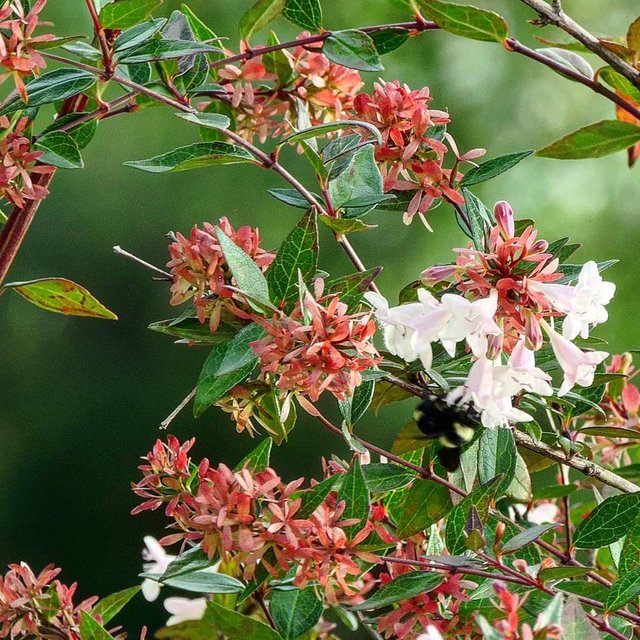
Abelia shrubs, Abelia grandiflora, have attractive foliage, which partially accounts for their longtime use in the landscape. The evergreen abelia has red foliage throughout the summer, becoming even deeper and more brilliant in autumn through winter. Flowers offer several bursts of bloom from spring to fall, with clusters of fragrant and frilly pink and white tubular flowers. In colder areas of the country, the glossy abelia plant is considered semi-evergreen, as it may lose half its leaves in cold winters.
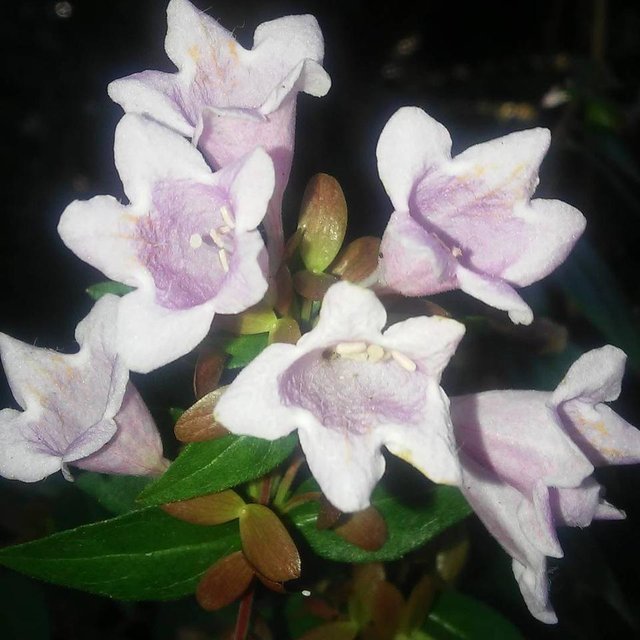
Abelia shrubs, Abelia grandiflora, have attractive foliage, which partially accounts for their longtime use in the landscape. The evergreen abelia has red foliage throughout the summer, becoming even deeper and more brilliant in autumn through winter. Flowers offer several bursts of bloom from spring to fall, with clusters of fragrant and frilly pink and white tubular flowers. In colder areas of the country, the glossy abelia plant is considered semi-evergreen, as it may lose half its leaves in cold winters.
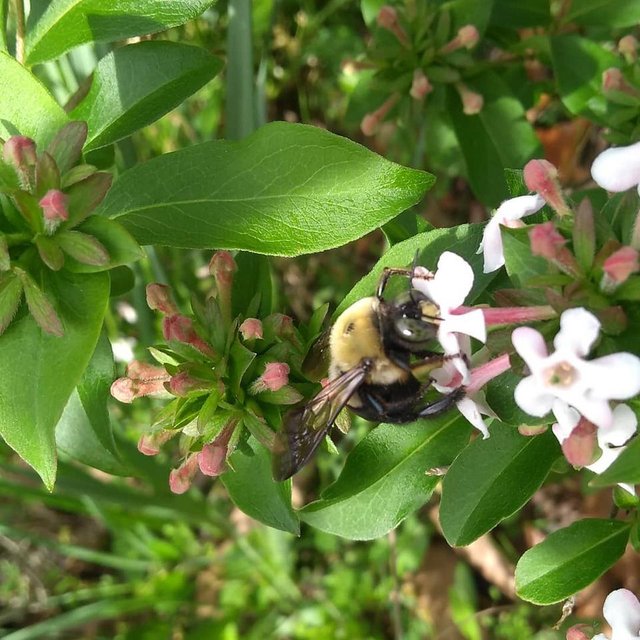
Great and amazing post.
Thanks @ctrl-alt-nwo for sharing this post. 🤗💙💜
Upvoted + resteemed your post.
Downvoting a post can decrease pending rewards and make it less visible. Common reasons:
Submit
Glossy Abelia
Abelia x grandiflora
Originally from Italy, this popular rounded shrub makes a fine hedge, barrier, mass or foundation plant. It also works to combat erosion when planted along a bank. Graceful, arching branches are covered with white flowers tinged with rose from late summer through the fall, attracting butterflies and bees.The glossy abelia is a versatile, easy-to-maintain option that will add year-round interest to any landscape.
This is a shade shrub, featuring a spreading canopy capable of blocking sunlight.The glossy abelia grows to a height of 3–6' and a spread of 3–6' at maturity.This shrub grows at a medium to fast rate, with height increases of anywhere from 13" to more than 24" per year.Full sun and partial shade are best for this shrub, meaning it prefers a minimum of 4 hours of direct, unfiltered sunlight each day.
Not known in general for its benefit to wildlife, these shrubs can serve as butterfly bushes.The glossy abelia originated in Italy possibly before 1866 but was supposedly not introduced until 1886.
https://www.arborday.org/trees/treeguide/TreeDetail.cfm?ItemID=644
Downvoting a post can decrease pending rewards and make it less visible. Common reasons:
Submit
This very beautiful garden and beautiful photography
thanks @ctrl-alt-nwo
Have a great day.
Downvoting a post can decrease pending rewards and make it less visible. Common reasons:
Submit
Abelia Culture
Abelia is easily grown in any type of soil that is not excessively boggy or dry. It grows well in full sun to part shade, though the best flowering is in full sun. Once established, abelia can withstand short periods of drought, but performs best with a deep soaking every two weeks.
Abelias are typically planted three or four feet apart as part of an informal shrub border, whether as a foundation planting, along with a property line or to divide different areas of the garden. The smaller varieties are also effective when used sporadically within beds of perennials.
Varieties
There are many varieties of abelia available in nurseries, including several with spectacular colored foliage.
Source
Downvoting a post can decrease pending rewards and make it less visible. Common reasons:
Submit
The Abelia ( Abelia x grandiflora ), a semi evergreen shrub cross between two Chinese species A. chinensis and A. uniflora, is the best known and most popular of the abelias. To 8 ft. or taller, spreading to 5 ft. or wider. Loses most of its leaves at 15°F/9°C. Freezes to the ground at 0°F/-18°C but usually recovers to bloom the same year, making a graceful border plant 10-15 in high.
Graceful arching branches densely clothed with ovel, usually glossy leaves 1/2-1 1/2 inches long; bronzy new growth. Tublar or bell shaped flowers in clusters at ends of branches or among leaves.
To keep the shrub's graceful form, prune selectively; don't shear. Abelias are adaptable plants, useful in shrub border, as space dividers and visual barriers, and near house walls; lower kinds are good bank or ground covers.
source
Thank you @ctrl-alt-nwo for creating colorful blog for knowledge and entertainment!
Downvoting a post can decrease pending rewards and make it less visible. Common reasons:
Submit
Abelia is an excellent choice for the landscape. It’s versatile and has many positive attractive leaves ranging from green to red with many cultivars to choose from- all with different unique attributes. Fine, small leaves make it a great contrast to other landscape plants.
Abelia is a genus of about 30 species and many hybrids in the honeysuckle family Caprifoliaceae. They are shrubs from 1-6m tall, native to eastern Asia and southern North America; the species from warm climates are evergreen and colder climates are deciduous. The leaves are opposite or in whorls of three, ovate, glossy, dark green, 1.5-8 cm long, turning purplish-bronze to red in autumn in the deciduous species. The flowers appear in the upper leaf axils and stem ends, 1-8 together in the short cyme; they are pendulous, white to pink, bell-shaped with a five-lobed corolla, 1-5 cm long, and usually scented. Flowering continues over a long and continuous period from late spring to fall.
Light Requirements:
Full sun
Water Requirements:
Water regularly weekly or more often in extreme heat. Requires less frequent watering, once established.
Frost Resistance:
Frost hardy
Feeding:
Prefers a more acid soil. A general fertiliser of 2:1:2 will do well for the plants.
Source
Downvoting a post can decrease pending rewards and make it less visible. Common reasons:
Submit
l have little information about adorable- abelia @ctrl-alt-nwo.
Downvoting a post can decrease pending rewards and make it less visible. Common reasons:
Submit
Abelia is a decorative shrub and is very suitable for growing in the garden!
Abelia - deciduous or evergreen, slowly growing ornamental shrub in height 1,5-2,5 m, under favorable growing conditions can reach a six-meter mark. Leaves opposite, pointed at the ends, oval in shape, dark green in color with shine, are located in pairs.
Flowers tubular, campanulate or funnel-shaped, small or medium-sized, five-lobed, have a pleasant and brightly-expressed odor, can be white, pink, lilac or red. Flowering runs from June to September, some species bloom until October. At the end of flowering, leaves densely located at the tips of branches fall off, and in their place remain reddish or purple sepals, due to which the plants retain their decorative qualities until the onset of stable frosts.
Growing conditions
Abelia - the plant photophilous, gives preference to well-lit areas. In a hot climate accepts slightly shaded areas, protected from the northern winds. To grow a culture, well-drained, moderately moist soils with a rich mineral composition are desirable.
Care
Abelia is an undemanding plant, taking care of it does not take much time and is subject to even a novice amateur gardener. The main tasks in the care of plants are forming and sanitary pruning. To maintain aesthetic views of the bush immediately after flowering, old, diseased and damaged branches should be removed. A special form of abelia can be given by shearing, however, it will be necessary to perform such a procedure quite often, since the plants grow very quickly.
In arid periods, the Abelians need moderate watering, with sufficient amount of natural precipitation the culture of irrigation does not require. Top dressing with mineral fertilizers is carried out in early spring. Since the Abelians are cold-resistant, there is no need for shelter for the winter.
An equally important procedure for caring for plants is the fight against the parents and diseases. Often, Abelians are attacked by aphids, the pest leaves saccharous discharge on the leaves, which subsequently lead to their blackening. To combat diseases and diseases it is recommended to use permitted insecticidal drugs. Thank you @ctrl-alt-nwo
http://zvetniki.ru/abeliya-dekorativnyiy-kustarnik/
Downvoting a post can decrease pending rewards and make it less visible. Common reasons:
Submit
Abelia, a great designer plant, is known not only for stunning autumn colors but also for its dramatic color throughout the year. Buzzle provides information on Abelia varieties and their characteristics.
Abelias are named after Dr. Clarke Abel, a surgeon who was appointed as the Chief Medical Officer to Lord Amherst's Embassy to China (1816-1817). Dr. Clarke was a keen naturalist too. Unfortunately, all the plants and seeds that he had collected in China were lost in a shipwreck when he was returning to England. Later, Scottish botanist Robert Fortune imported plants of Abelia chinensis in 1844, and of Abelia uniflora in 1849.
The genus Abelia contains about 30 different species of flowering shrubs and a number of hybrids. These popular flowering plants belong to the family Caprifoliaceae (Linnaeaceae). They are native to eastern Asia (from Western Japan to the Himalayan ranges) and southern part of North America (Mexico). They are described as 'semi-evergreen shrubs', because the species that grow in colder regions are deciduous (they may lose half of the leaves in winter). Plants growing in warmer regions can be evergreen. Abelias require little or no maintenance.
source
Downvoting a post can decrease pending rewards and make it less visible. Common reasons:
Submit
I know this plants Abelia - long-flowering shrub for home and garden. But Abelia is a rare visitor in our country, because the climate does not allow her to grow. Her name was given by Clark Abel (1780-1826), English botanist and zoologist, doctor, researcher of flora and fauna of China, India and Indonesia. Abelia is appreciated for beautiful fragrant flowers, elegant appearance of bushes and long flowering.

Plants prefer sunny places or a light shadow. The soil must be well drained. Summer in the heat requires abundant watering.
After flowering, remove old and damaged shoots.
With ease grown in common, medium, well-drained soil in full solar to part color. Satisfactory flowering in full sun. Prefers moist, organically wealthy soils which drain well. Somewhat evergreen within the South, but on the whole deciduous within the St. Louis area the place stems may undergo substantial harm (together with dying to the ground) in bloodless winters. Gigantic stem injury can be expected when winter temperatures method zero levels F. Exceptional sited in a protected vicinity in the St. Louis subject. Blooms on new timber, so prune as wanted (e.G., remove stems misplaced to iciness and, if preferred, thin to the bottom as much as 1/3 of old stems) in late winter to early spring.

Graceful, arching branches densely clothed with oval, usually glossy leaves 1/2–1 1/2 inches long; bronzy new growth. Tubular or bell-shaped flowers in clusters at ends of branches or among leaves. Though small, blossoms are plentiful enough to be showy, mostly during summer and early fall. When blooms drop, they usually leave purplish or copper-colored sepals that provide color into the fall months. Leaves also may take on bronzy tints in fall.

Downvoting a post can decrease pending rewards and make it less visible. Common reasons:
Submit
With ease grown in common, medium, well-drained soil in full solar to part color. Satisfactory flowering in full sun. Prefers moist, organically wealthy soils which drain well. Somewhat evergreen within the South, but on the whole deciduous within the St. Louis area the place stems may undergo substantial harm (together with dying to the ground) in bloodless winters. Gigantic stem injury can be expected when winter temperatures method zero levels F. Exceptional sited in a protected vicinity in the St. Louis subject. Blooms on new timber, so prune as wanted (e.G., remove stems misplaced to iciness and, if preferred, thin to the bottom as much as 1/3 of old stems) in late winter to early spring.
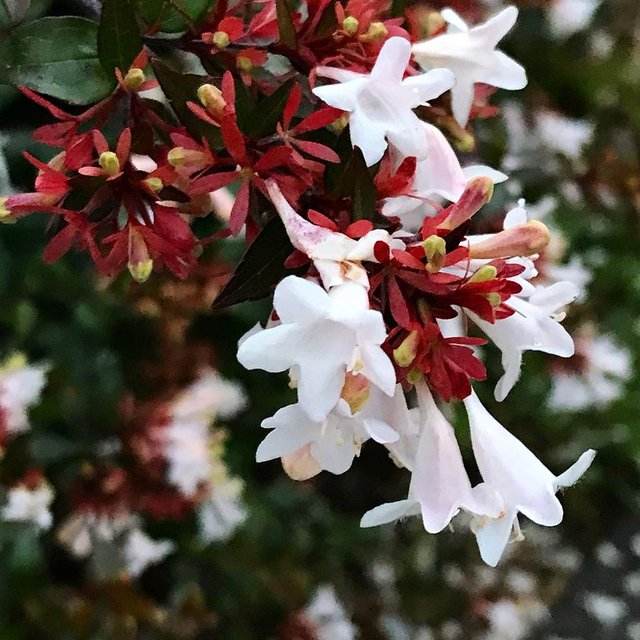
Abelia grandiflora is a go between A. Chinensis and A. Uniflora. It is a rounded, spreading, multi-stemmed shrub in the honeysuckle household. Often grows on gracefully arching branches to 2-four' tall in the St. Louis subject, however frequently taller (to 6' tall ) within the heat iciness climates of the South (USDA Zones 8-9). In years the place the stems die to the bottom in iciness but the plant survives, flowering will still arise, but on smaller plants that generally reach a top of only one-1.5'. Facets clusters of white-tinged-red, bell-shaped plant life (to three/four" long) which appear within the upper leaf axils and stem ends over a protracted and steady late spring to fall bloom interval. Flowers are aromatic. Ovate, glossy, darkish green leaves (to 1.25" lengthy) flip purplish-bronze in autumn.
Genus name honors Dr. Clarke Abel (1780-1826), general practitioner and naturalist, who gathered seed and crops as a part of a British expedition to China in 1817.
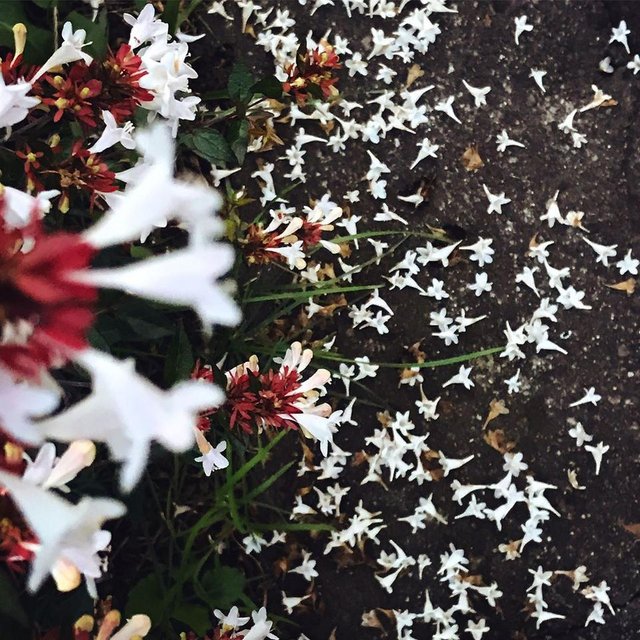
No critical insect or disorder issues. Wintry weather die-again could arise within the St. Louis field.
Specimen or grouping or mass for shrub borders or foundations. Additionally effective as an casual hedge or low display (vegetation tend to lose attractive sleek shape if pruned or sheared to a extra formal hedge appear) in southern areas the place winter kill just isn't a challenge. Mass on slopes or banks for appealing shrubby duvet and erosion manipulate.
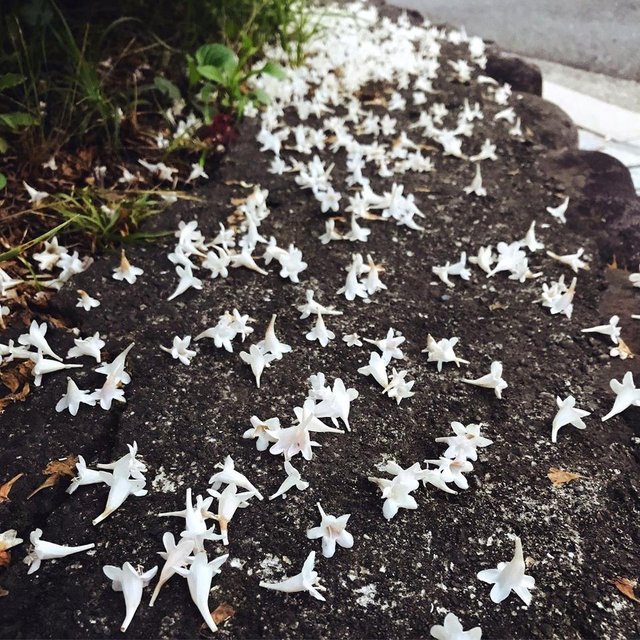
Downvoting a post can decrease pending rewards and make it less visible. Common reasons:
Submit
Glossy abelia is a fine-textured, semi-evergreen, sprawling shrub with 1½ inch-long, red-tinged leaves arranged along thin, arching, multiple stems. It is a hybrid between A. chinensis and A. uniflora. It stands out from other plants because the leaves retain the reddish foliage all summer long, whereas many plants with reddish leaves lose this coloration later in the summer. Considered to be evergreen in its southern range, glossy abelia will lose 50% of its leaves in colder climates, and the remaining leaves will take on a more pronounced red color. Reaching a height of 6 to 10 feet with a spread of 6 feet, the gently rounded form of glossy abelia is clothed from spring through fall with terminal clusters of delicate pink and white, small, tubular flowers. Multiple stems arise from the ground in a vase shape, spreading apart as they ascend into the foliage.
Abelia x grandiflora blooms
A. x grandiflora 'Kaleidoscope'
A. x grandiflora 'Kaleidoscope' foliage
Persistent caylx
Scientific name: Abelia x grandiflora
Common name(s): glossy abelia, largeflower abelia
Plant type: shrub
Use and Management
Glossy abelia grows in an upright, spreading vase shape if left unpruned with numerous thin stems arising from the ground. Stems eventually branch near their tips forming a shrub with a full top and a thin bottom. The cascading nature of glossy abelia makes it ideal for use as a specimen, foundation plant, or shrub border. It also can be planted along a steep bank for erosion control, or it can be clipped into a hedge. Be sure that the top of the hedge is clipped narrower than the bottom to allow adequate light to reach the bottom foliage. This will help keep the plant full all the way to the ground.
Foliage arises maroon fading to dark green, lending a reddish cast to the plant during active growth. The small powderpuff-pink flowers add color continuously during the warm months. Blooming on new growth in the summer, glossy abelia benefits from springtime pruning and will require occasional thinning to keep it in bounds as a hedge. Thinning will help light reach the interior foliage, stimulating branching and creating a fuller plant.
Glossy abelia enjoys fairly rich, moist but well-drained soil in a full sun or lightly shaded location and has good drought tolerance. Plants become thin and unattractive in the shade and do not flower. Plant on 4- to 6-foot centers to form a screen or foundation planting, slightly closer for a hedge. The foliage darkens during the winter, but plants generally remain full all during the cold months.
Cultivars include: 'Confetti'—cream-variegated foliage, cream colored area turns reddish in cool weather, evergreen to about 10 degrees; 'Francis Mason'—new green foliage changes to glossy yellow as it matures, color more noticeable in full sun, light pink flowers, 3 to 4 feet high; 'Prostrata'—prostrate growth habit, white flowers, sometimes used as a ground cover; and 'Sherwoodii'—dwarf, to 3 feet, somewhat smaller leaves and flowers. Abelia 'Edward Goucher', a hybrid between Abelia x grandiflora and Abelia schumannii, has abundant lavender-pink flowers and showy red calyces, reaches 5 to 8 feet, and is best used in USDA hardiness zone 6 and south. It is superior to most other abelia due to the highly fragrant pink flowers.
Propagation is by cuttings of long, leafless, hardwood stems taken in November to January.
Downvoting a post can decrease pending rewards and make it less visible. Common reasons:
Submit
Abelia x grandiflora is a hybrid of Abelia chinensis and Abelia uniflora. Both the parents are form central china. The plant is commonly known as glossy Abelia. It is the most widely grown Abelia hybrid.
It is a great designer plant, is known not only for stunning autumn colors but also for its dramatic color throughout the year.
Abelias are named after Dr. Clarke Able, s surgeon who was appointed as the Chief Medical Officer to Lord Amherst's Embassy to China was a keen naturalist too.
The genus Abelia contains about 30 different species of flowering shrubs and a number of hybrids.
These popular flowering plants belong to the family Caprifoliaceae (Linnaeaceae). They are native to eastern Asia (from Western Japan to the Himalayan ranges) and southern part of North America (Mexico).
Abelia is a prolific bloomer of fragrant flowers. The trumpet-shaped, scented flowers have a five-lobed corolla. The tublar white flowers have a light purple-pink tinge.
The shrubs grow well in full sun and can be 1-6 m tall. The plants grow well in sandy, loam, or clay soils. The gracefully arching branches add to the beauty of the plant.
These plants attract hummingbirds, bees and butterflies. They look nice in borders, however they are suitable for containers gardens, patios, and foundations too.
source
Downvoting a post can decrease pending rewards and make it less visible. Common reasons:
Submit
Most Abelia species have a densely bushy habit, often with slightly arching branches and small glossy leaves that taper to a fine point. The young foliage has bronze to golden tints that in some cultivars persist to maturity. From late summer, small, full-shaped to tubular, white to pink flowers smother the bushes. Some species have persistent reddish sepals that provide an additional ornamental feature after the flowers have faded.
Although hardiness varies considerably, most abelias are not suitable in areas with severe winters. Plant in a position in sun or part-shade with moist, humus-rich, well-drained soil. Pruning should be undertaken to keep the plant looking tidy whilst maintaining its natural arching habit. Trim to shape in late winter or spring, removing the cane ends and also some of the basal shoots in order to allow room for new growth. Propagate from half-hardened or softwood cuttings.
Source- http://www.abc.net.au/gardening/plant-finder/abelia/9441910
Downvoting a post can decrease pending rewards and make it less visible. Common reasons:
Submit
#Abelia-X-grandiflora :
This is a rounded, semi-evergreen shrub to 10 feet tall and 12 feet wide with glossy, dark green leaves. From midsummer to autumn, it produces fragrant, funnel-shaped white flowers that are tinged with pink.
Details in shortcut :
Culture:
Easily grown in average, medium, well-drained soil in full sun to part shade. Best flowering in full sun. Prefers moist, organically rich soils which drain well. Somewhat evergreen in the South, but generally deciduous in the St. Louis area where stems may suffer substantial damage (including dying to the ground) in cold winters. Significant stem damage can be expected when winter temperatures approach zero degrees F. Best sited in a protected location in the St. Louis area. Blooms on new wood, so prune as needed (e.g., remove stems lost to winter and, if desired, thin to the ground up to 1/3 of old stems) in late winter to early spring.
Problems:
Anthracnose, leaf spots, powdery mildew, and fungal root rots may occur.
Basic care instruction :
#Plant Feed:
Slow release feed in spring.
#Watering:
Keep well-watered.
#Soil:
Well-drained, slightly acidic soil.
#Basic Care Summary:
 src
src
For best results, plant in acidic, fertile but well-drained soil. Keep soil moist, watering freely in dry weather. Prune back early each spring for best display.
Downvoting a post can decrease pending rewards and make it less visible. Common reasons:
Submit
Abelia ( Abelia x grandiflora ):
Abela is more attractive to me.
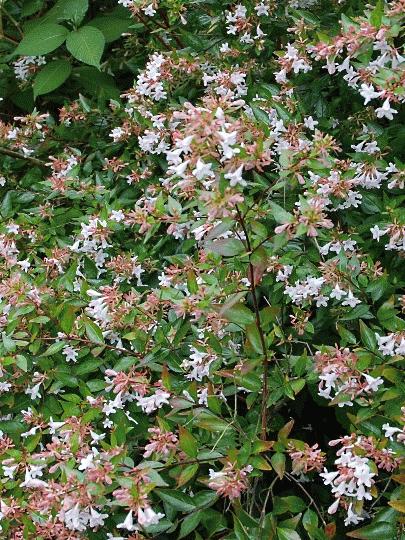

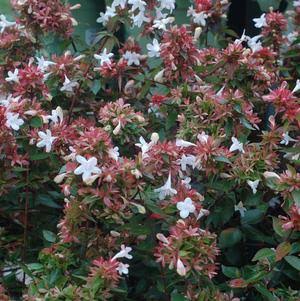.jpg)
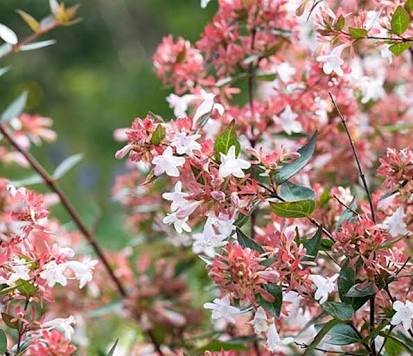.jpg)
Abelia shrubs are one of those old fashioned plants that became popular because of interesting foliage, showy flowers, reliable performance and simple abelia care. Learn how to grow abelia in your landscape for these characteristics. Newer cultivars of the glossy abelia plant provide a range of colors and forms. Abelia shrubs, Abelia grandiflora, have attractive foliage, which partially accounts for their longtime use in the landscape.
The evergreen abelia has red foliage throughout the summer, becoming even deeper and more brilliant in autumn through winter. Flowers offer several bursts of bloom from spring to fall, with clusters of fragrant and frilly pink and white tubular flowers. In colder areas of the country, the glossy abelia plant is considered semi-evergreen, as it may lose half its leaves in cold winters.
When planting abelia in your yard, choose a prominent spot, as abelia shrubs are no longer just to hide the foundation of your home. Also, choose a spot that gets full to partial sun. The glossy abelia plant grows in a variety of soil types, but responds best to a fertile soil.
Little is need with regards to the care of these shrubs, though regular watering improves performance. When growing the standard Abelia grandiflora, leave room for the plant to spread to 6 feet and reach 6 to 10 feet in height. The habit of the glossy abelia plant is to spread. Newer cultivars are more compact and require less pruning; therefore, abelia care is less time consuming. ‘Lavender Mist’ spreads only slightly, with gray green foliage that becomes a purplish red in fall and a deep purple in winter. Blooms on these compact abelia shrubs are lavender and white, with two heavy bloom periods in June and August. Prune this abelia in early spring once it is established.
‘Plum Surprise’ is another of the newer offerings, with less flowering and more finely textured foliage. Arching stems sport yellow-green leaves which become emerald in summer, turning burgundy as temperatures cool. Reddish stems often bear single flowers that appear white on first glance, but when examined closely, have a purple blush and yellow throat. This glossy abelia plant is tolerant of drought and summer heat once established in the landscape. Abelia care for this cultivar includes early spring pruning.
Downvoting a post can decrease pending rewards and make it less visible. Common reasons:
Submit
Most Abelia species have a thickly rugged propensity, frequently with somewhat angling branches and little reflexive leaves that decrease to a fine point. The youthful foliage has bronze to brilliant tints that in a few cultivars persevere to development. From pre-fall, little, full-formed to tubular, white to pink blooms cover the brambles. A few animal categories have industrious rosy sepals that give an extra fancy element after the blossoms have blurred.
In spite of the fact that solidness changes significantly, most abelias are not appropriate in zones with serious winters. Plant in a situation in sun or part-shade with soggy, humus-rich, very much depleted soil. Pruning ought to be embraced to keep the plant looking clean while keeping up its characteristic angling propensity. Trim to shape in pre-spring or spring, evacuating the stick closes and furthermore a portion of the basal shoots keeping in mind the end goal to permit space for new development. Engender from half-solidified or softwood cuttings.
Downvoting a post can decrease pending rewards and make it less visible. Common reasons:
Submit
magoo-2 found a series of multi accounts of a same owner is following your articles to cheat your generous rewards.
magoo-2 found these accounts are suspicious & can be multi accounts of a single owner. Conclusion is based on last 30 days transactions:
@rik432
@ratul8940
@rahul72
@taylor10
@villani
@wilson6
@masud90
@purepinag
@sumonsha
@perry1
@max1994
magoo-2
Check our latest multi comment spam update report
Downvoting a post can decrease pending rewards and make it less visible. Common reasons:
Submit
Abelia
Abelia /əˈbiːliə/[1] is a formerly recognized genus that contained about 30 species and hybrids, placed in the honeysuckle family, Caprifoliaceae. Molecular phylogenetic studies showed that the genus was not monophyletic, and in 2013, Maarten Christenhusz proposed the merger of Abelia (excluding section Zabelia) into Linnaea, along with some other genera. Abelia section Zabelia was raised to the genus Zabelia.[2]
Description
Species formerly placed in Abelia are shrubs from 1–6 m tall, native to eastern Asia (Japan west to the Himalaya) and southern North America (Mexico); the species from warm climates are evergreen, and colder climate species deciduous. The leaves are opposite or in whorls of three, ovate, glossy, dark green, 1.5–8 cm long, turning purplish-bronze to red in autumn in the deciduous species. The flowers appear in the upper leaf axils and stem ends, 1-8 together in a short cyme; they are pendulous, white to pink, bell-shaped with a five-lobed corolla, 1–5 cm long, and usually scented. Flowering continues over a long and continuous period from late spring to fall.
Taxonomy
The generic name commemorates Clarke Abel, a keen naturalist who accompanied Lord Amherst's unsuccessful embassy to China in 1816 as surgeon, under the sponsorship of Sir Joseph Banks. All of Abel's seeds and plants were lost in a shipwreck on the homeward voyage, however; living plants of Abelia chinensis (now Linnaea chinensis) were first imported to England in 1844 by Robert Fortune.[3]
Some species placed in Abelia were transferred to Linnaea at various times from 1872 onwards, but these transfers were not accepted by most botanists. Molecular phylogenetic studies showed that a number of genera traditionally placed in the tribe Linnaeeae were closely related, but that Abelia was not monophyletic, even with Abelia section Zabelia split off as a separate genus Zabelia. In 2013, Maarten Christenhusz proposed that Abelia and related genera be merged into Linnaea.[2] This proposal has been adopted by recent sources, including the Plants of the World Online.[4][5]
https://en.wikipedia.org/wiki/Abelia
Downvoting a post can decrease pending rewards and make it less visible. Common reasons:
Submit
magoo-2 found a series of multi accounts of a same owner is following your articles to cheat your generous rewards.
magoo-2 found these accounts are suspicious & can be multi accounts of a single owner. Conclusion is based on last 30 days transactions:
@rik432
@ratul8940
@rahul72
@taylor10
@villani
@wilson6
@masud90
@purepinag
@sumonsha
@perry1
@max1994
magoo-2
Check our latest multi comment spam update report
Downvoting a post can decrease pending rewards and make it less visible. Common reasons:
Submit
Downvoting a post can decrease pending rewards and make it less visible. Common reasons:
Submit
Every time you give us different and beautiful pants and it's valuable for more details from the web site. In some countries, some of the native plants are an excellent plant to see Abulia.
The best flower of the full sun is moist, fragrant soil which takes good drips. Somewhere in the south, but in the St. Louis area, there may be reasons for death on the ground due to the typical damage to the cold winter season in thin containers. In the beginning of zero degrees early winter temperatures can be estimated to be significant stem damage. Located in the best protected area of St. Louis area. Like new wooden flowers, plants are lost in winter due to need, and if desired, thin slab from the soil should be placed in the winter in winter.
![marguerite-729510_640.jpg]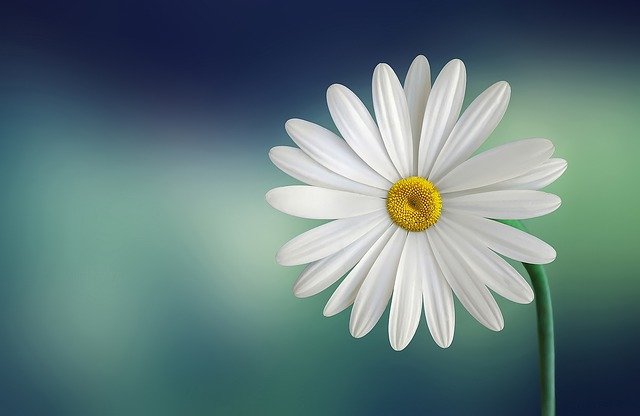 )
)
(
Downvoting a post can decrease pending rewards and make it less visible. Common reasons:
Submit
Thankyou, but where's the Abelia ?
Downvoting a post can decrease pending rewards and make it less visible. Common reasons:
Submit
Good for you
Downvoting a post can decrease pending rewards and make it less visible. Common reasons:
Submit
look it so much beautiful... amazing flowers ... i just love to read this.. mind blowing colour... also wonderful smell... thanks for sharing this lovely flowers.. waiting for your next post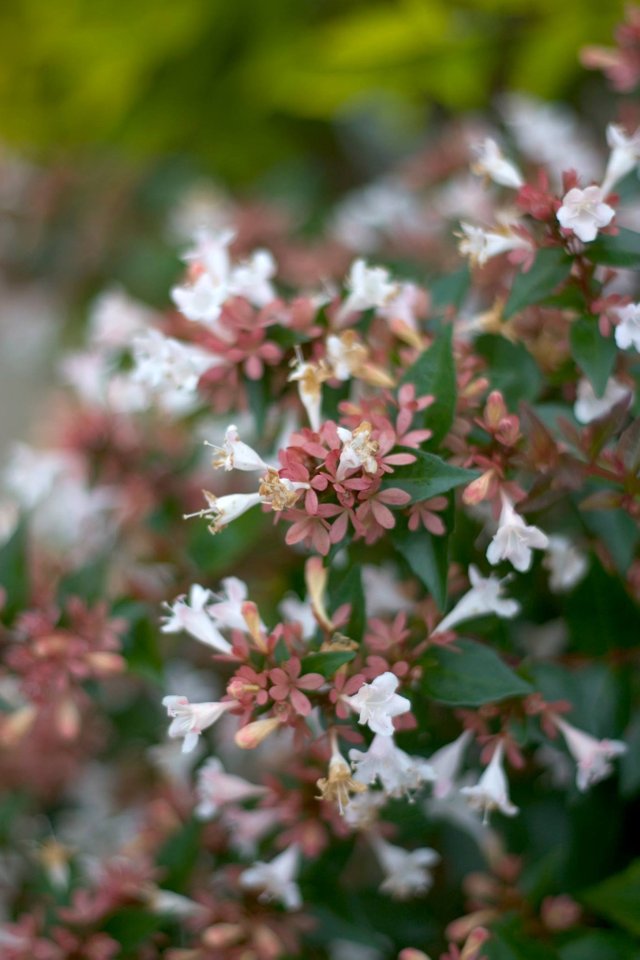
Downvoting a post can decrease pending rewards and make it less visible. Common reasons:
Submit
Pterocapus
At South East Asia, there is a country named " Myanmar " also known as Golden Land. Why Golden Land ? There have a lot of golden Pagoda .
Okey ! It is why of the name golden land.
And There are a lot of fastival in these country . There is a fastival in a month and 12 fastivalsin a year. The famous is water fastival .It is from April 13 th to April 16 th , today is the last day of fastival.
Now I am writing about Pterocapus and It has a relationship with water fastival.Because this Pterocapus can be seen in the period of water fastival.Why?
In April , there is a little rain and that is the beginning of the rainy season . When the rain is falling on the Pterocapus Tree , the Pterocapus flower was born with beauty in a period of a little hours.
Yeah ! that is a relationship of Pterocapus flower and Myanmar Water Fastival . See my all friends how these Pterocapus flower how beautiful .
Thank to all Steemians
@ngwezinyaw
Downvoting a post can decrease pending rewards and make it less visible. Common reasons:
Submit
Wow amazing & beautiful Hardly Drab garden.
For your post propagation.
Upvote/Resteem
Downvoting a post can decrease pending rewards and make it less visible. Common reasons:
Submit
That is a amazing trees and really beautiful flowers. the beat garden.
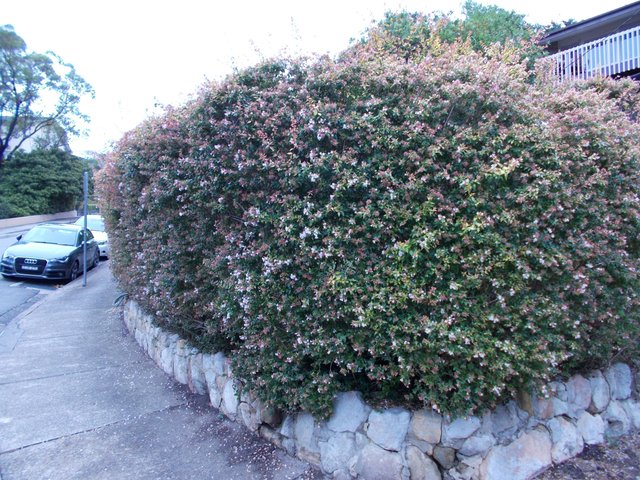
Thanks for the information
@ctrl-alt-nwo
100% like and resteem
Downvoting a post can decrease pending rewards and make it less visible. Common reasons:
Submit
So beautiful garden, thanks for sharing

Resteem
Downvoting a post can decrease pending rewards and make it less visible. Common reasons:
Submit
Adorable. Your blog is every time an inspiration for flower ethusiasts like myself. Keep up the good work!
Downvoting a post can decrease pending rewards and make it less visible. Common reasons:
Submit
Abelia is a formerly recognized genus that contained about 30 species and hybrids, placed in the honeysuckle family, Caprifoliaceae. Molecular phylogenetic studies showed that the genus was not monophyletic, and in 2013, Maarten Christenhusz proposed the merger of Abelia (excluding section Zabelia) into Linnaea, along with some other genera. Abelia section Zabelia was raised to the genus Zabelia.
Species formerly placed in Abelia are shrubs from 1–6 m tall, native to eastern Asia (Japan west to the Himalaya) and southern North America (Mexico); the species from warm climates are evergreen, and colder climate species deciduous. The leaves are opposite or in whorls of three, ovate, glossy, dark green, 1.5–8 cm long, turning purplish-bronze to red in autumn in the deciduous species. The flowers appear in the upper leaf axils and stem ends, 1-8 together in a short cyme; they are pendulous, white to pink, bell-shaped with a five-lobed corolla, 1–5 cm long, and usually scented. Flowering continues over a long and continuous period from late spring to fall.
The generic name commemorates Clarke Abel, a keen naturalist who accompanied Lord Amherst's unsuccessful embassy to China in 1816 as surgeon, under the sponsorship of Sir Joseph Banks. All of Abel's seeds and plants were lost in a shipwreck on the homeward voyage, however; living plants of Abelia chinensis (now Linnaea chinensis) were first imported to England in 1844 by Robert Fortune.
Some species placed in Abelia were transferred to Linnaea at various times from 1872 onwards, but these transfers were not accepted by most botanists. Molecular phylogenetic studies showed that a number of genera traditionally placed in the tribe Linnaeeae were closely related, but that Abelia was not monophyletic, even with Abelia section Zabelia split off as a separate genus Zabelia. In 2013, Maarten Christenhusz proposed that Abelia and related genera be merged into Linnaea.This proposal has been adopted by recent sources, including the Plants of the World Online.
[Source]( Wikipedia and google.)
Downvoting a post can decrease pending rewards and make it less visible. Common reasons:
Submit
Magoo-2 found a series of multi accounts of a same owner is following your articles to cheat your generous rewards.
Magoo-2 found these accounts are suspicious & can be multi accounts of a single owner. Conclusion is based on last 30 days transactions:
@abdulmanan
@johnjohny
@bablibablu
@mudasraraza
@mudasra
magoo-2
Check our latest multi comment spam update report
Downvoting a post can decrease pending rewards and make it less visible. Common reasons:
Submit
Hi there, can you please explain how you work out if people have multiple accounts? Thanks.
Downvoting a post can decrease pending rewards and make it less visible. Common reasons:
Submit
can I explain it?
As you know we can see each other's transactions,
each and everything of other's user, posts, comments, upvotes, devotes,
so in order check multi accounts? just check their transactions, if these belong to one person, he would be sending the reward to one account, like i was doing.
here I want to tell you something, you know that getting noticed is something is the most difficult thing here on the steemit platform, and I have a family to support, that's why I was using multiple accounts, but I was spending my whole day commenting to get some sbd's to support.
But if you think I wasn't doing the right thing, I won't do it again.
and if you allow me to comment from my original id, which is this id.
I'll comment, otherwise, I'll not.
Thank you <3
God bless you.
Downvoting a post can decrease pending rewards and make it less visible. Common reasons:
Submit
So are you saying that you are magoo-2 and abdulmanan is your other account?? If you are not magoo-2, then thanks for explaining, but i am still waiting for an answer from magoo-2.
Downvoting a post can decrease pending rewards and make it less visible. Common reasons:
Submit
No no i am not magoo-2!
I am just asking for the permission that can i comment on your posts or not?
Downvoting a post can decrease pending rewards and make it less visible. Common reasons:
Submit
Yes of course you can comment . Everybody is welcome to comment, but i would ask that there will be only one comment for each person.
Downvoting a post can decrease pending rewards and make it less visible. Common reasons:
Submit
Okay Thank you now i will comments from this id!
Thanks for the permission!
Downvoting a post can decrease pending rewards and make it less visible. Common reasons:
Submit
@ctrl-alt-nwo glad to see another post from you.
@abelia is one of the beautiful plant.
A visually striking and hardy, evergreen/semi-evergreen, medium to large shrub with graceful arching branches. The new foliage is golden in colour, ageing to a medium to dark green with buttery yellow margins. Small tubular flowers in Summer and are an attractant to butterflies.
The thicket like habit means that the plant is able to be clipped into a hedge to give excellent contrast to neighboring green shrubs, or grown as specimen plantings. Performs best in well drained soils but is tolerant of soils ranging from sandy to clayey with minimal to regular watering required, depending upon conditions. Dislikes wet feet. Tolerates light frosts. Prune in spring to remove old wood.
Some Specifications:
Dimensions Height: 1 to 2m, Width: 2m
Aspect Full shade
Origin China
Pests & diseases No specific pests or diseases.
Typical sizes 200mm
source
Downvoting a post can decrease pending rewards and make it less visible. Common reasons:
Submit
Magoo-2 found a series of multi accounts of a same owner is following your articles to cheat your generous rewards.
Magoo-2 found these accounts are suspicious & can be multi accounts of a single owner. Conclusion is based on last 30 days transactions:
@abdulmanan
@johnjohny
@bablibablu
@mudasraraza
@mudasra
magoo-2
Check our latest multi comment spam update report
Downvoting a post can decrease pending rewards and make it less visible. Common reasons:
Submit
Downvoting a post can decrease pending rewards and make it less visible. Common reasons:
Submit
I know this plants Abelia - long-flowering shrub for home and garden. But Abelia is a rare visitor in our country, because the climate does not allow her to grow. Her name was given by Clark Abel (1780-1826), English botanist and zoologist, doctor, researcher of flora and fauna of China, India and Indonesia. Abelia is appreciated for beautiful fragrant flowers, elegant appearance of bushes and long flowering.
Plants prefer sunny places or a light shadow. The soil must be well drained. Summer in the heat requires abundant watering.
After flowering, remove old and damaged shoots.
Thanks for the cognitive post @ctrl-alt-nwo
http://www.vashsad.ua/more/reserves/show/9411/
Downvoting a post can decrease pending rewards and make it less visible. Common reasons:
Submit
Abelia is s very attractive and useful plants! At first I thouhgt these flowers look very much like jasmine. But in your comment section there are so many different photos including the pink varieties!
I am going to investigate whether I could find this plant in Thailand. These can become fence as well!
Thank you for all your effort and sharing these valuable information. You have set up a database for me!
Cheers.
Downvoting a post can decrease pending rewards and make it less visible. Common reasons:
Submit
I'm happy it is useful to you !!
Downvoting a post can decrease pending rewards and make it less visible. Common reasons:
Submit
Abelia x grandiflora
Description
A beautiful, medium sized, semi-evergreen shrub with arching branches and lightly scented, white flowers, lightly tinged with pink throughout late summer. The flowers of Abelia x grandiflora are long lasting and stand out well against the dark green, glossy leaves.
As a semi-evergreen shrub, Abelia x grandiflora tends to be evergreen in mild winters but can loose its leaves in very cold periods.
Superb choice of shrub for planting as part of a low maintenance mixed border, growing in a container or against a wall or fence.
Supplied Size: 3L containers (approx three year old plants, 30 - 40 cm tall)
Position: Full sun or light, dappled shade.
Soil: Any fertile soil.
Hardiness: Hardy. Abelia x grandiflora requires shelter from cold winter winds.
Flowering Period: July - October
Flower Colour: Pale pinkish-white
Rate of Growth: Moderate.
Habit: Abelia x grandiflora grows to be a medium sized, rounded, densely branching shrub.
Height: eventually up to 2.5 m (8 ft) / or up to 1.5 - 2 m (5 - 6 ft) after 10 years
Spread: eventually 3 m (10 ft) / or up to 2 - 2.5 m (6 - 8 ft) after 10 years
Pruning: Abelia x grandiflora should be pruned in late spring to shape or remove any dead or damaged wood if required.
http://www.bluebellnursery.com/catalogue/trees/Abelia/A/5203252?gclid=EAIaIQobChMIyejT5qK22gIVRQ4rCh0wrA70EAAYASAAEgL-dvD_BwE
Downvoting a post can decrease pending rewards and make it less visible. Common reasons:
Submit
magoo-2 found a series of multi accounts of a same owner is following your articles to cheat your generous rewards.
magoo-2 found these accounts are suspicious & can be multi accounts of a single owner. Conclusion is based on last 30 days transactions:
@rik432
@ratul8940
@rahul72
@taylor10
@villani
@wilson6
@masud90
@purepinag
@sumonsha
@perry1
@max1994
magoo-2
Check our latest multi comment spam update report
Downvoting a post can decrease pending rewards and make it less visible. Common reasons:
Submit
ABELİA x GRANDİFLORA



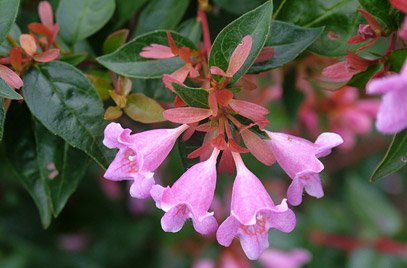

Culture:
Easily grown in average, medium, well-drained soil in full sun to part shade. Best flowering in full sun. Prefers moist, organically rich soils which drain well. Somewhat evergreen in the South, but generally deciduous in the St. Louis area where stems may suffer substantial damage (including dying to the ground) in cold winters. Significant stem damage can be expected when winter temperatures approach zero degrees F. Best sited in a protected location in the St. Louis area. Blooms on new wood, so prune as needed (e.g., remove stems lost to winter and, if desired, thin to the ground up to 1/3 of old stems) in late winter to early spring.
Noteworthy Characteristics:
Abelia × grandiflora is a cross between A. chinensis and A. uniflora. It is a rounded, spreading, multi-stemmed shrub in the honeysuckle family. Typically grows on gracefully arching branches to 2-4' tall in the St. Louis area, but usually taller (to 6' tall ) in the warm winter climates of the South (USDA Zones 8-9). In years where the stems die to the ground in winter but the plant survives, flowering will still occur, but on smaller plants that typically reach a height of only 1-1.5'. Features clusters of white-tinged-pink, bell-shaped flowers (to 3/4" long) which appear in the upper leaf axils and stem ends over a long and continuous late spring to fall bloom period. Flowers are fragrant. Ovate, glossy, dark green leaves (to 1.25" long) turn purplish-bronze in autumn.
Varieties:
Conti
Dwarf Purple
Edward Goucher
Francis Mason
Little Richard
Sherwoodii
Sunrise
Source1
Source2
Thanks for reading @ctrl-alt-nwo
Downvoting a post can decrease pending rewards and make it less visible. Common reasons:
Submit
Magoo-2 found a series of multi accounts of a same owner is following your articles to cheat your generous rewards.
Magoo-2 found these accounts are suspicious & can be multi accounts of a single owner. Conclusion is based on last 30 days transactions:
@dangerux
@cointurk
@thegossip
@bburak30
@embesilikat
@kagantrky
@amalinavia
@gesund
@kksafak
@bado
@fkorkmaz
@bahriyeli
@ygmraykt
@ucmuharfli
@mertkrtsss
@curious4
@alkmaar
magoo-2
Check our latest multi comment spam update report
Downvoting a post can decrease pending rewards and make it less visible. Common reasons:
Submit
@magoo-2 who are you and on what grounds do you draw your conclusion? Respond me please in your post.
Downvoting a post can decrease pending rewards and make it less visible. Common reasons:
Submit
you have 17 account
Downvoting a post can decrease pending rewards and make it less visible. Common reasons:
Submit
It's not true. The accounts that you have listed here, I see the first time.
Downvoting a post can decrease pending rewards and make it less visible. Common reasons:
Submit
he is a idiot
Downvoting a post can decrease pending rewards and make it less visible. Common reasons:
Submit
@magoo-2 Do not you see I'm broadcasting live? If you investigated me, you would have seen it. Do you realize what you blame me? You have to give up now. You should speak with evidence. Show me proof.
Downvoting a post can decrease pending rewards and make it less visible. Common reasons:
Submit
@magoo-2
I don't know this account!!!
You are a liar
Downvoting a post can decrease pending rewards and make it less visible. Common reasons:
Submit
Abelia
The homeland is China. The green shrub is in the form of a small bush falcon. Almost all parts of our crops are grown. Can be used as a good fence plant. The height is 1.5 m to 2 m. most suitable and 1.5 m wide. Abelia has a normal growth rate. At the end of autumn, the right pink-white flowers bloom 1 cm in size, resembling small bells. 1-1.5 cm in size, oval-shaped, with teeth on the sides of the flowers are. Driving the leaves in dark green has a bright appearance.
Abelia enjoys semi-shadows and shadows wherever the land climate dominates in light wishes, and sun and shade can be used in every space near the sea.


Water desires are up to the average garden plant. It may leave its leaves at places where the temperature falls below -5, but it will recover quickly in the spring. However, in very cold weather the plant must be protected. He suffered from severe frost incidents. The plant can withstand temperatures as low as -10 ° C. The plant will die at lower temperatures. If you put two handfuls of Worm Guinea at the root of the plant in spring, it will be lusher and bloom more than normal.
The soil likes well drained and permeable soils. Humus and sandy soil is good for development. The soil of the plant should be low moist. He does not like very moist soil. Moderate salt resistant.
The flowering time is from July to October. It is ostentatious, white or pink in color, and the bowl leaves are reddish. There is 1 seed in the fruit.


Use in Landscape: Abelia is a plant suitable for use in gardens that are planted in tropical garden style due to their glossy leaves. In addition, leaves and flowers in a miniature size make the plant Abelia an ideal plant in oriental gardens. Because of its sagging form, Abelia is also suitable for use in large flower pots or cups as well as on the ground. The wall can be made more decorative when it is suspended from the middle height retaining walls. When Abelia is planted in rows, it can be used as a hedge plant to limit unwanted images and set boundaries. Since the leaves or other parts of the plant are not spilled, it is a clean plant, so it is suitable for use at the edge of the pool or patio. If desired, it can be kept under control by pruning.
Source
Downvoting a post can decrease pending rewards and make it less visible. Common reasons:
Submit
Magoo-2 found a series of multi accounts of a same owner is following your articles to cheat your generous rewards.
Magoo-2 found these accounts are suspicious & can be multi accounts of a single owner. Conclusion is based on last 30 days transactions:
@justdothat
@harunbaki
@justshowme
@gifhy
@lessismoring
magoo-2
Check our latest multi comment spam update report
Downvoting a post can decrease pending rewards and make it less visible. Common reasons:
Submit
Downvoting a post can decrease pending rewards and make it less visible. Common reasons:
Submit
Dealing with the plants is a very enjoyable and beautiful effort, making the person stratified and happy. To protect nature, we need to be an example to our children.





There are thirty types of abelia (abelia), which are more popularly known as 'beauty work'. These plants, which are native to China, belong to the family of lepidoptera (caprifoliaceae). The genus name of the plant was given to Clarke Abel, the naturalist.
Abelia in shrub form does not spill its leaves in temperate climates. The bright green colored leaves turn red in the autumn and give the plant a distinct beauty.
The most popular and grown 'abelia grandiflora' is a hybrid species. At the end of the shoots, small bell-shaped pinkish white and slightly fragrant flowers open. The flowering period starts from June and lasts until September.
Abelia grows in the best temperate climates. But it is also resistant to cold, hot and salty. Humusian likes rich, moist lands and sunny or semi-shaded places. The butterfly and the bees attract themselves. For this reason, it is also called 'butterfly work'. Some species are mossy and dwarf.
Abelia is easy to grow, does not want much maintenance. Ideal for parks and gardens, it can be shaped with pruning. It is made of steel and seeds.
All photos belong to
Downvoting a post can decrease pending rewards and make it less visible. Common reasons:
Submit
Magoo-2 found a series of multi accounts of a same owner is following your articles to cheat your generous rewards.
Magoo-2 found these accounts are suspicious & can be multi accounts of a single owner. Conclusion is based on last 30 days transactions:
@justdothat
@harunbaki
@justshowme
@gifhy
@lessismoring
magoo-2
Check our latest multi comment spam update report
Downvoting a post can decrease pending rewards and make it less visible. Common reasons:
Submit
wow,,
its abelia
looking so pretty awesome
Downvoting a post can decrease pending rewards and make it less visible. Common reasons:
Submit
Magoo-2 found a series of multi accounts of a same owner is following your articles to cheat your generous rewards.
Magoo-2 found these accounts are suspicious & can be multi accounts of a single owner. Conclusion is based on last 30 days transactions:
@rahmanmdriad
@mdriadrahman26
@masterlegend
magoo-2
Check our latest multi comment spam update report
Downvoting a post can decrease pending rewards and make it less visible. Common reasons:
Submit
Well I have never really seen it but it does indeed looks very beautiful !
The 2nd image is indeed looking amazing !
Downvoting a post can decrease pending rewards and make it less visible. Common reasons:
Submit
Wawooo thats nice post as well as garden with fresh flowers and also great wall of stone @ctrl-alt-nwo
Downvoting a post can decrease pending rewards and make it less visible. Common reasons:
Submit
The Abelia plant makes a scattered hill and grows at medium speed. The maximum height he can do is 2-3 meters. Abelia, which has fine hairy shoots, makes shallow roots. Leaves are always green in warm climates, summer green or cold in cold climates. Leaves are 1.5-3 cm long, egg-shaped; edges are lightly threaded, pointed spike, upper surface is very bright dark green; bottom surface is light, bright, green color. Autumn coloring is brown or reddish.

Significant Diseases and Harms Encountered
Root rot, stalk, chlorosis, fungus diseases and aphid, molluscus and tetranychus are fighting.
Ecological Requests

In cold climatic conditions, it must be protected. It is damaged from severe frost. It can withstand temperatures up to -10 ° C. -15 0 C then death. some developed species have more resistance to cold. It is a light-half-shadow plant and likes warm, temperate and sunny places. It likes acidic, slightly alkaline, sandy, well-drained and permeable soils. Moderate salt resistant.
Important Types
Abelia x grandiflora 'Kaleidoscope', Abelia grandiflora 'Francis Mason', Abelia grandiflora 'Canyon Creek', Abelia grandiflora 'Little Richard', Abelia grandiflora 'Rosa Creek' are important species.
Dwarf Abelya - Yellow Mottled (Abelia x grandiflora 'Kaleidoscope')

It is 80 to 100 cm high and wide, with a variety of stunted abelian leaves with very distinctive variegated leaves in their red branches. The leaves are bright yellow with a light green outside in the middle of the spring. In summer, gold is yellowish and the center is green. In the fall, it is a golden horn, a bright orange and a red hue.
Light pink dense tiny flowers form from summer to autumn.
It gives the most beautiful colors in full sunny places. Semi-shaded areas can also be grown. It develops better on permeable soils in many soil types. Growth in heavy clayey soils and high-Ph soil is not good.
Because it is based on -25 degree cold, it can be easily grown in many regions of the home. In landscaping, gardening or pots, you can grow yellow variegated dwarf abalone.

Pic source
Downvoting a post can decrease pending rewards and make it less visible. Common reasons:
Submit
Magoo-2 found a series of multi accounts of a same owner is following your articles to cheat your generous rewards.
Magoo-2 found these accounts are suspicious & can be multi accounts of a single owner. Conclusion is based on last 30 days transactions:
@justdothat
@harunbaki
@justshowme
@gifhy
@lessismoring
magoo-2
Check our latest multi comment spam update report
Downvoting a post can decrease pending rewards and make it less visible. Common reasons:
Submit
thanks a lot sir for introducing such amazing plants,you are doing a job which is next to imposible.
Downvoting a post can decrease pending rewards and make it less visible. Common reasons:
Submit
Downvoting a post can decrease pending rewards and make it less visible. Common reasons:
Submit
Nice Cyclamen pics, but they are not Abelia.
Downvoting a post can decrease pending rewards and make it less visible. Common reasons:
Submit
Abelia leaves are dark green and glossy, and the tubular flowers are small, white or pink that grow in clusters, Abelia shrubs flower between spring and autumn...
Downvoting a post can decrease pending rewards and make it less visible. Common reasons:
Submit
Magoo-2 found a series of multi accounts of a same owner is following your articles to cheat your generous rewards.
Magoo-2 found these accounts are suspicious & can be multi accounts of a single owner. Conclusion is based on last 30 days transactions:
@mumin007
@naqshab02
@muhasib
@sheikhiqra
@hariszahoor
@zahidmalik
@chaddiman
magoo-2
Check our latest multi comment spam update report
Downvoting a post can decrease pending rewards and make it less visible. Common reasons:
Submit
Adorable Abelia awesome work,this is amazing,great work sir.
Downvoting a post can decrease pending rewards and make it less visible. Common reasons:
Submit
I didn't here about this plant before...really beautiful flowers photography.☺
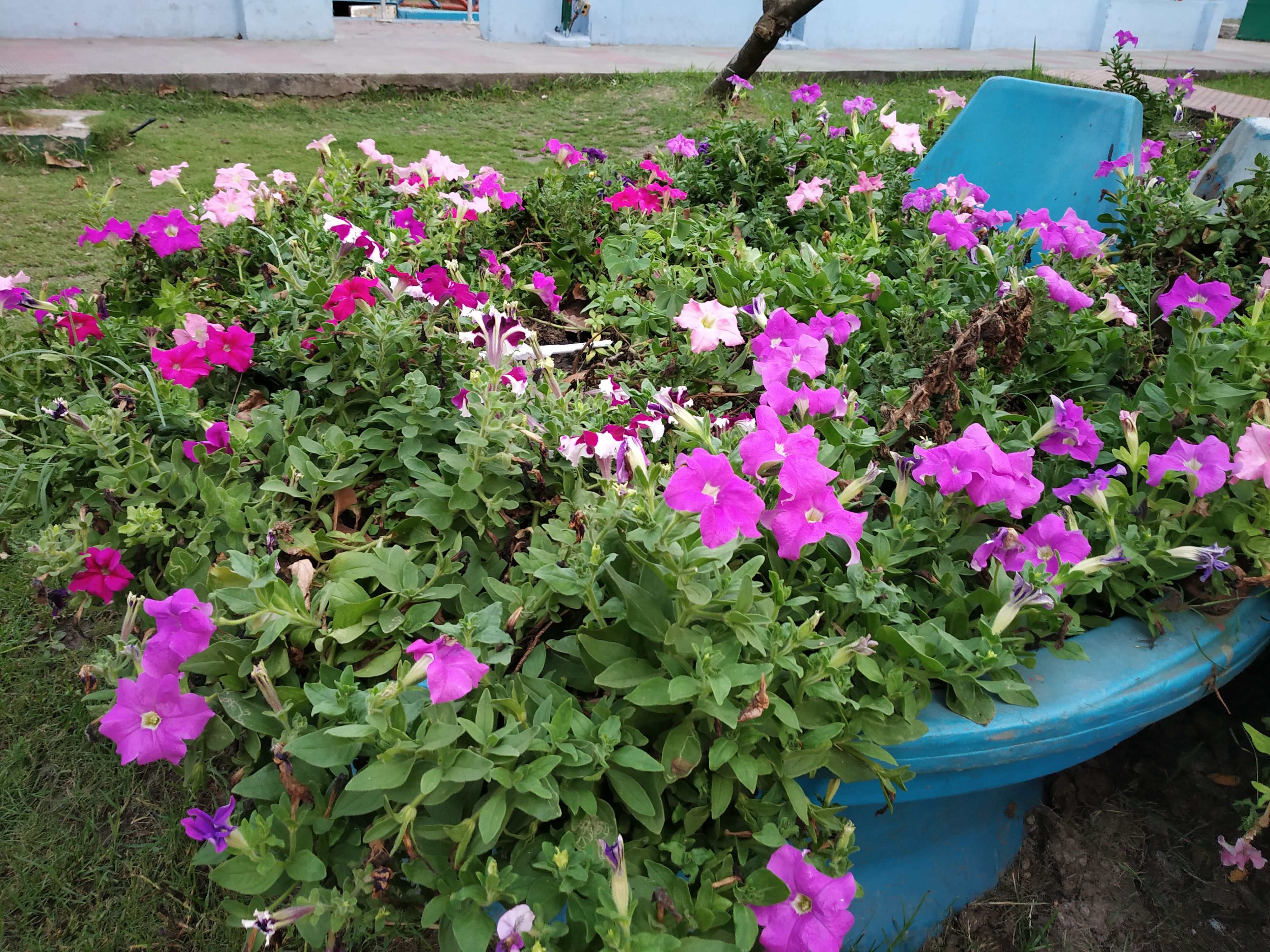
Downvoting a post can decrease pending rewards and make it less visible. Common reasons:
Submit
Species formerly placed in Abelia are shrubs from 1–6 m tall, native to eastern Asia (Japan west to the Himalaya) and southern North America (Mexico); the species from warm climates are evergreen, and colder climate species deciduous. The leaves are opposite or in whorls of three, ovate, glossy, dark green, 1.5–8 cm long, turning purplish-bronze to red in autumn in the deciduous species. The flowers appear in the upper leaf axils and stem ends, 1-8 together in a short cyme; they are pendulous, white to pink, bell-shaped with a five-lobed corolla, 1–5 cm long, and usually scented. Flowering continues over a long and continuous period from late spring to fall.
Downvoting a post can decrease pending rewards and make it less visible. Common reasons:
Submit
@ctrl-alt-nwo.... That's a exclusive information about Adorable Abelia. When I search in Google about Adorable Abelia , I noticed that they received some information steemit just few times ago.however Adorable Abelia is a beautiful gardening shurb.
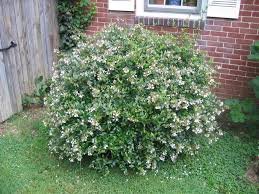.jpeg)
It Most popular in south africa.they like to gardening infornt of their house.
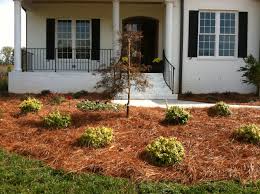.jpeg)
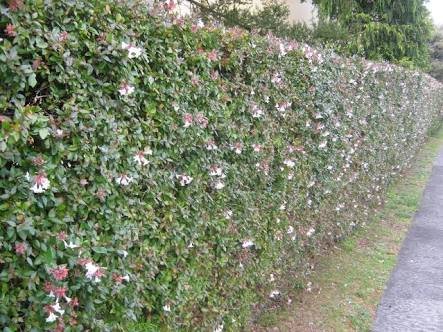.jpeg)
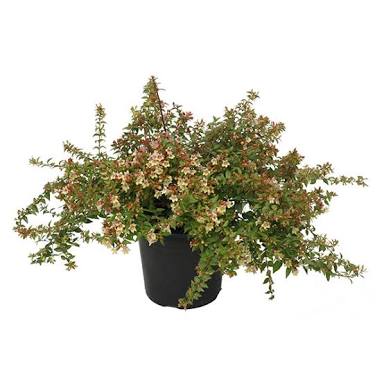.jpeg)
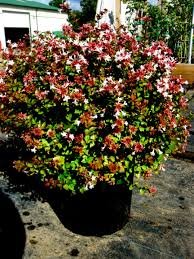.jpeg)
Sometimes it used like a boundary get.
Someone it plants on a tob.
First time I seen it and foll in love.
All pictures source from Google.
Downvoting a post can decrease pending rewards and make it less visible. Common reasons:
Submit
Magoo-2 found a series of multi accounts of a same owner is following your articles to cheat your generous rewards.
Magoo-2 found these accounts are suspicious & can be multi accounts of a single owner. Conclusion is based on last 30 days transactions:
@ritue
@pariza
@suchi
@maicle
@quinnpeterson
@ziaurrahma
@steemitsabbir1
@utpolbiswas
@davitone
@steemitsabbir1
magoo-2
Check our latest multi comment spam update report
Downvoting a post can decrease pending rewards and make it less visible. Common reasons:
Submit
@magoo-2...you are wrong.it is single id and use a single person.but you mentioned those id that we work with a community.so you should report with carefully.
Downvoting a post can decrease pending rewards and make it less visible. Common reasons:
Submit
Abelia it looks like perfect house decoration. Probably easy to maintain too. I like Magnolia trees now as they bloom in my part of the world. But I think a tree is way harder to maintain than a simple bush.
Oh, and nice flowers, great post ;)
both photos are from Pinterest
Downvoting a post can decrease pending rewards and make it less visible. Common reasons:
Submit
It's beautiful flowers entire small bunch of plant. Better explained here @ctrl-alt-nwo.
Abelias are among those old fashioned shrubs that modern gardeners simply can’t do without, because they are available in all sizes, from petite to large. There is an ideal one for your size garden even if you only have a small balcony, it can boast a dwarf potted Abelia!
Smaller gardens need smaller shrubs, and it can be a challenge to find shrubs that remain small without the need for ruthless pruning. Plant breeders recognised this need and were delighted when they persuaded Abelia to produce more petite offspring. These new and exciting cultivars are genetic dwarfs and simply do not grow as large as their parents. This breakthrough led to a wonderful selection of these adorable babies, with the same graceful form as their parents, and a wonderful selection of leaf colours, including lemon, gold, cream or even pink variegations, not forgetting the profusion of tiny bell-shaped flowers Abelia is loved for.
Abelia is a large family of plants belonging to the beautiful honeysuckle family and there are both evergreen and deciduous species. They are native to eastern Asia, from Japan to the Himalayas, as well as Mexico; the species from warm climates are evergreen, and those from colder climates are deciduous.
Source: http://www.gardeninginsouthafrica.co.za/index.php/1256-may/abelias-are-among-those-old-fashioned-shrubs-that-the-modern-gardener-simply-can-t-do-without
Downvoting a post can decrease pending rewards and make it less visible. Common reasons:
Submit
Adorable Abelia is amazing sir,thanks a lot sir,you always brings us such plants we never know,thanksyou so much sir for introducing this.
Downvoting a post can decrease pending rewards and make it less visible. Common reasons:
Submit
It really is adorable... They look wonderful when they got dew drops on them...
Downvoting a post can decrease pending rewards and make it less visible. Common reasons:
Submit
Very beautiful tree
You are a successful and really wonderful person
Downvoting a post can decrease pending rewards and make it less visible. Common reasons:
Submit
Stunning photography sir but i dnt know i cnt hear this flower nme before.... Is this new one?????..
Thnxxx fr sharing...☺☺👌👌👌
Downvoting a post can decrease pending rewards and make it less visible. Common reasons:
Submit
nice post
Downvoting a post can decrease pending rewards and make it less visible. Common reasons:
Submit
nice blog & excellent photo
Downvoting a post can decrease pending rewards and make it less visible. Common reasons:
Submit
This looks really awesome which is awesome to see nice pictures and information :)
Downvoting a post can decrease pending rewards and make it less visible. Common reasons:
Submit
Stunning photography sir but i dnt know i cnt hear this flower nme before flowers
Downvoting a post can decrease pending rewards and make it less visible. Common reasons:
Submit
very beautiful and awesome
Downvoting a post can decrease pending rewards and make it less visible. Common reasons:
Submit
Downvoting a post can decrease pending rewards and make it less visible. Common reasons:
Submit
Hello!! Hope you are okay! Too busy I suppose.
I am rushed off my feet too! So much work in the garden and with the cats.
Downvoting a post can decrease pending rewards and make it less visible. Common reasons:
Submit
Abelia × grandiflora ‘Brockhill Allgold’
Abelia can be deciduous or evergreen shrubs or small trees. The leaves are paired or whorled. The flowers are axillary or terminal clusters of funnel-shaped or trumpet-shaped and come out in in summer and autumn.
SUN: The plant likes full sun but in a sheltered spot.
MOISTURE: Moist but well-drained
SOIL: Sand, Chalk, Loam
pH: Acid, Alkaline, Neutral
For an image and more info go to the RHS
website https://www.rhs.org.uk/Plants/317515/i-Abelia-i-times;-i-grandiflora-i-Brockhill-Allgold/Details
Downvoting a post can decrease pending rewards and make it less visible. Common reasons:
Submit